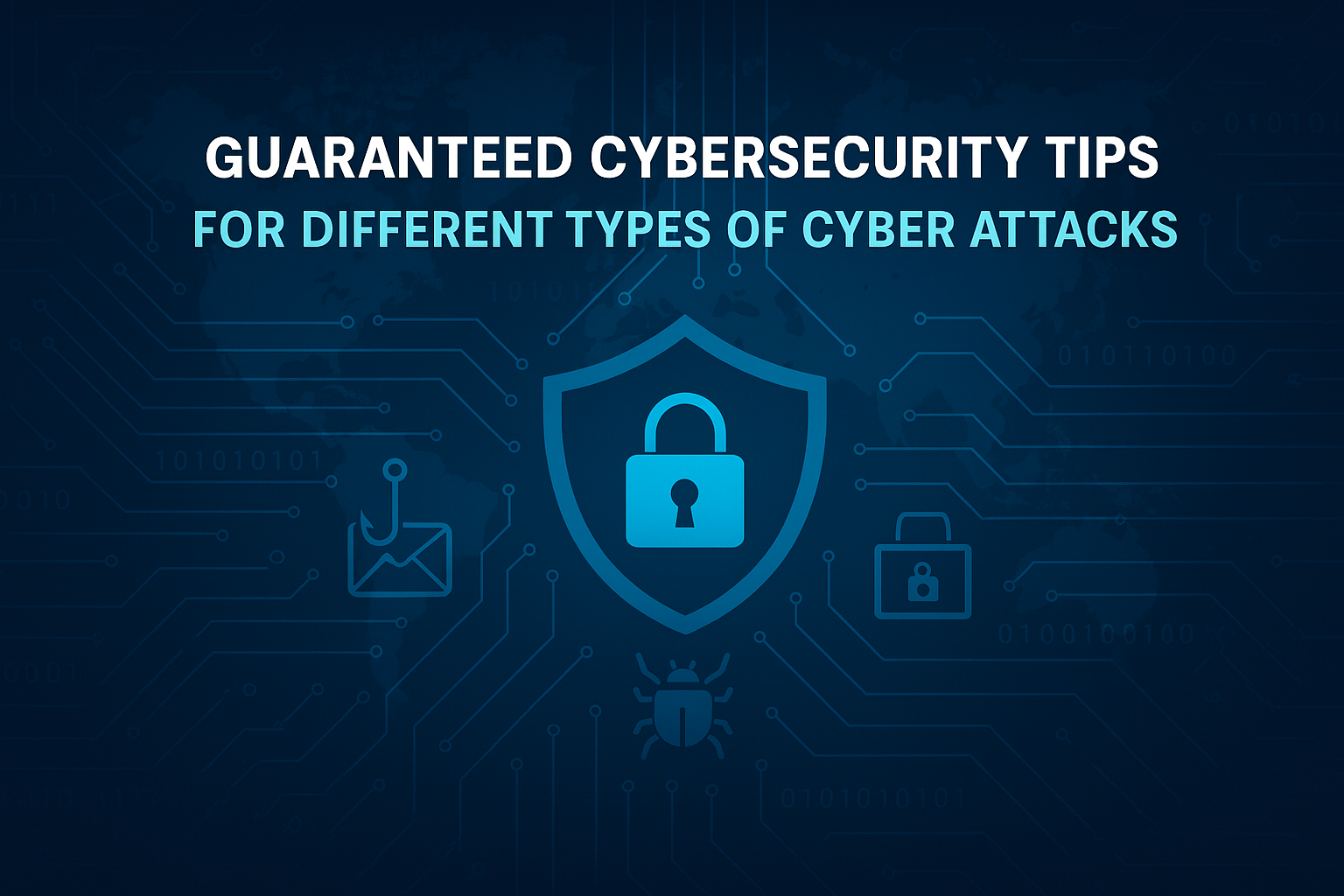
Table of Contents
In the context of the hyper-connectivity of India, cybersecurity is essential for everyone-whether you’re a student, a business owner, or simply someone who enjoys browsing the internet. As our reliance on digital platforms grows, so does the need to protect our personal and professional information from the different types of cyber attacks that are becoming increasingly common. The categories of cyber attack targeting common people range from financial fraud to data breaches, impacting individuals and organizations alike.
Cybersecurity is not just about having advanced technology; it’s about cultivating cybersecurity awareness tips that empower you to recognize and respond to threats. With India achieving Tier 1 status in the Global Cybersecurity Index, there’s a strong foundation, but cybercriminals are also becoming more sophisticated. That’s why understanding the different types of attack in cyber security and adopting practical cybersecurity tips is crucial for everyone. By staying informed and vigilant, we can collectively build a safer digital environment for ourselves and our communities.
Cybersecurity isn’t just about technology-it’s about building a culture of awareness and resilience. By understanding the risks and following expert tips, you can protect your data, your business, and your peace of mind, ensuring that your marketing strategies for startup business and online ventures thrive securely in our country’s vibrant cyberspace.
Understanding Different Types of Cyber Attacks
The world has witnessed a dramatic surge in cyber incidents, with reported cases multiplying over the past decade. To defend ourselves, it’s vital to understand the categories of cyber attack most prevalent in our country and all over the world:
- Phishing Attacks: These are deceptive attempts to trick you into revealing sensitive information, such as passwords or bank details, often via fake emails or websites. Phishing is one of the most widespread different types of cyber attacks in India, impacting both individuals and businesses.
- Malware and Ransomware: Malware refers to malicious software that can steal data or damage your device. Ransomware, a specific category, locks your files and demands payment for their release. Both are common different types of attack in cyber security and have been known to cause significant losses for the affected parties.
- Social Engineering: This involves manipulating people into divulging confidential information. Techniques include impersonation, baiting, and tech support scams, making it a particularly insidious category of cyber attack.
- DDoS (Distributed Denial of Service): DDoS attack involves flooding online services with excessive traffic, causing outages and financial losses. These different types of cyber attacks are increasingly targeting businesses, especially in the financial sector.
- Insider Threats: Sometimes, threats come from within an organization-employees or partners misusing their access to sensitive data.
By understanding these different types of attack in cyber security, you can better prepare yourself with effective cybersecurity tips and cybersecurity awareness tips.
Phishing Attacks: Prevention and Protection Tips

Phishing is a type of cyberattack where an attacker poses as a legitimate entity to get the victim to divulge their personal information. Phishing is one of the most dangerous types of cyber attack , with attackers using increasingly clever tactics. Here are essential cybersecurity tips to help you avoid falling victim:
- Scrutinize Emails and Messages: Always verify the sender’s details and be wary of unsolicited messages, especially those urging immediate action. Phishing emails often mimic trusted organizations or government agencies, making it crucial to double-check URLs and sender addresses.
- Check Website Security: Before entering sensitive information, ensure the website uses HTTPS (HyperText Transfer Protocol Secure) and has a valid SSL (Secure Sockets Layer) certificate. Fake websites are a common tool in phishing campaigns, one of the most prevalent categories of cyber attack.
- Never Share Sensitive Information via Pop-Ups: Legitimate organizations will never ask for confidential information through pop-up windows. If you encounter such requests, it’s best to close the window and contact the organization directly.
- Educate Yourself and Others: Stay updated on the latest phishing trends and regularly participate in cybersecurity awareness tips sessions. Knowledge is your best defense against these different types of cyber attacks.
- Use Antivirus and Keep It Updated: Reliable antivirus software can detect and block many phishing attempts, adding an extra layer of protection.
Following these cybersecurity tips can significantly reduce your risk of falling prey to phishing, one of the most damaging different types of attack in cyber security.
Malware and Ransomware: Safeguarding Your Devices

Malware and ransomware are among the most destructive categories of cyber attacks, targeting individuals and organizations alike. Here’s how to protect your digital assets:
- Keep Software Updated: Regularly update your operating system and applications to patch vulnerabilities that cybercriminals exploit. Outdated software is a common entry point for malware and ransomware, two different types of cyber attacks that can cripple your devices.
- Use Strong, Unique Passwords: Complex passwords make it harder for attackers to gain unauthorized access. Consider using passphrases or a reputable password manager for added security-this is a key cybersecurity tip for everyone.
- Install Firewalls and Antivirus: These tools provide a robust defense against unauthorized access and malicious software. Make sure your antivirus is always up to date to counter the latest threats.
- Restrict Administrative Privileges: Limit administrative access to only those who need it. This minimizes the damage if a device is compromised by malware or ransomware, a crucial step in your cybersecurity awareness tips checklist.
- Enable Two-Factor Authentication (2FA): 2FA adds an extra verification step, making it much harder for attackers to breach your accounts-even if they have your password.
- Backup Your Data Regularly: Maintain secure backups on external drives or cloud storage. If ransomware strikes, you can restore your data without paying the ransom.
Social Engineering Attacks: How to Defend Yourself

Social engineering attacks are cyberattacks that manipulate people into divulging sensitive information or taking actions that compromise their security, often through psychological manipulation or deception. These attacks exploit human trust and can be done through various channels like email, phone, or even in person. Here’s how to defend yourself:
- Be Skeptical of Unsolicited Requests: Always verify the identity of anyone asking for sensitive information, whether by phone, email, or in person. Social engineers often impersonate trusted individuals, making this a critical cybersecurity awareness tip.
- Educate Yourself About Common Tactics: Learn to recognize phishing, pretexting, and baiting-common different types of cyber attacks used in social engineering. Awareness is your first line of defense.
- Enable Two-Factor Authentication: 2FA can prevent unauthorized access even if your credentials are compromised through social engineering, reinforcing your cybersecurity tips arsenal.
- Report Suspicious Activity: If you suspect you’ve been targeted, report it to your organization’s IT team or relevant authorities. Quick action can prevent further damage and help others avoid similar attacks.
- Foster a Security-Conscious Culture: Encourage open discussions about cybersecurity awareness tips within your family or workplace. Sharing experiences and strategies strengthens collective defense against these different types of attack in cyber security.
DDoS Attacks: Mitigation and Recovery Techniques
A Distributed Denial-of-Service (DDoS) attack is a type of cyberattack where numerous systems bombard a target with excessive traffic, rendering it inaccessible to legitimate users. The goal is to exhaust the target’s resources, leading to significant slowdowns or even total downtime.
Unlike a traditional Denial-of-Service (DoS) attack from a single source, a DDoS attack leverages a network of compromised devices, known as a botnet, to intensify its impact. Here are key cybersecurity tips for mitigation and recovery:
- Invest in DDoS Protection Services: Specialized services can detect and mitigate DDoS attacks in real time, minimizing downtime and financial losses. This is especially important for businesses that rely on online platforms.
- Develop an Incident Response Plan: Have a clear plan outlining steps to take during a DDoS attack, including communication protocols and technical measures. Regular drills ensure everyone knows their role, which is a vital cybersecurity awareness tip.
- Monitor Network Traffic: Use advanced monitoring tools to detect unusual spikes in traffic, which may signal the onset of a DDoS attack. Early detection allows for quicker response and less disruption.
- Collaborate with Your ISP: Internet service providers (ISP) can help filter malicious traffic during a DDoS attack, providing an additional layer of defense against these different types of cyber attacks.
Implementing these cybersecurity tips can help you recover quickly and effectively from DDoS attacks, one of the most disruptive categories of cyber attack.
Protecting Your Business from Insider Threats

Insider threats whether intentional or accidental pose significant risks to all kinds of businesses. Here’s how to protect your organization:
- Implement Access Controls: Restrict access to sensitive data based on job roles. This limits the potential damage if an insider misuses their privileges-a key cybersecurity tip for any organization.
- Monitor User Activity: Use security tools to track and analyze employee actions, looking for unusual patterns that may indicate insider threats. Continuous monitoring is a crucial cybersecurity awareness tip for businesses.
- Foster a Culture of Trust and Responsibility: Encourage employees to report suspicious behavior and provide regular training on the different types of attack in cyber security. A well-informed team is your best defense against insider threats.
Best Practices for Strong Password Management

Strong password management is a cornerstone of cybersecurity for individuals and businesses alike. Here’s how to create and maintain secure passwords:
- Use Complex Passwords: Create passwords that combine uppercase and lowercase letters, numbers, and special characters. Avoid using easily guessable information like birthdays or common words.
- Implement Password Managers: Password managers securely store and generate unique passwords for each account, reducing the risk of reuse and weak credentials. This is especially important for businesses handling multiple accounts related to marketing strategies for online business.
- Enable Multi-Factor Authentication (MFA): MFA adds an extra layer of security by requiring additional verification, such as a fingerprint or OTP, making it much harder for attackers to gain access.
- Change Passwords Regularly: Update passwords periodically and immediately after any suspected breach. Educate employees and collaborators about the importance of password hygiene to protect your business marketing strategies.
The Role of Regular Software Updates in Cybersecurity
Keeping your software and systems updated is one of the simplest yet most effective ways to prevent cyber threats. Software updates often include patches for newly discovered vulnerabilities that attackers could exploit.
Enable automatic updates for operating systems, applications, and security tools, and regularly check for updates on all devices used for business marketing strategies, marketing strategies for startup business, and online operations. By staying current, you close security gaps and strengthen your overall cyber defense.
Conclusion: Staying Vigilant Against Cyber Threats
Cybersecurity is everyone’s responsibility. As we navigate an increasingly digital world, understanding the different types of cyber attacks and adopting practical cybersecurity tips is essential for protecting ourselves and our loved ones.
By staying informed about the categories of cyber attack, practicing cybersecurity awareness tips, and practicing a culture of vigilance, we can create a safer online environment for all. Remember, the best defense is a proactive one-so keep learning, stay alert, and encourage others to do the same. Together, we can outsmart cyber threats and build a secure digital future.




